How Do You Keep A 100 Gallon Tank Clean
To ensure your fish stay good for you, information technology'southward vital to ensure you keep the conditions of your tank optimal.
This requires routine maintenance and cleaning to assistance maintain the frail ecosystem in your tank.
Water in your aquarium can easily become harmful to your fish if it is not maintained correctly.
By maintaining and cleaning your tank correctly, you won't always need to remove all of the water at in one case. In fact, past doing this, you lot kill all of the proficient bacteria that have built upwardly.
Advertisements
If y'all are a consummate beginner, you may think that information technology's easier to clean a small tank or basin; this is an incorrect assumption. The larger the aquarium the easier it is to keep the h2o stable, y'all tin can read more about why that is, here.
To understand Why You Need to Make clean Your Fish Tank, The Importance of Regular Cleaning, How Often Should You lot Clean Your Tank, Adequate Aquarium Parameters, and How to Clean a Fish Tank in Five Like shooting fish in a barrel Steps then keep reading.
Why You Need to Clean Your Fish Tank
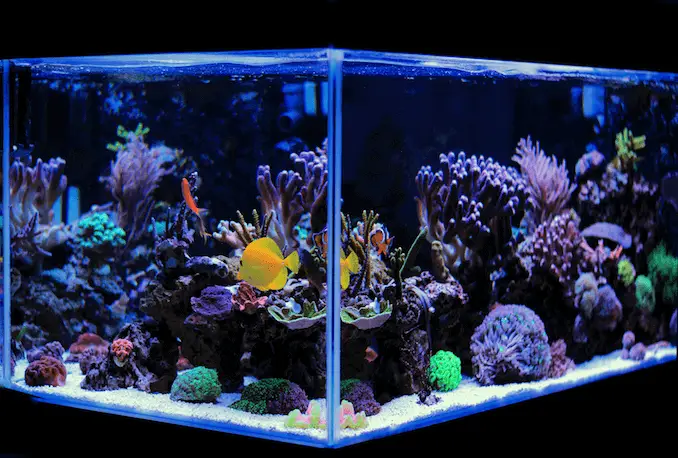
There are iii goals you are trying to achieve when you clean your fish tank; these are known as the three Rs.
- Regulate the nitrogen cycle
- Remove dissolved and particulate organic compounds
- Furnish essential minerals
1. To keep the nitrates in low concentration
The nitrogen bicycle is the procedure in which ammonia is converted past bacteria to nitrite and and then to nitrate. Both ammonia and nitrite are toxic to fish, and then having bacteria colonies in your fish tank is essential to catechumen them harmful compounds to nitrate.
Nitrates are much less harmful to fish and can be removed by regular h2o changes.
Before y'all introduce whatsoever fish to a tank, ideally information technology will take been cycled; there are a number of unlike ways to cycle your tank. Ane of the amend ways is to add artificial ammonia to your tank to start edifice upward the bacteria colony which breaks down ammonia and nitrites.
2. To remove dissolved and particulate organic compounds
Organic compounds are divers by chemists every bit those that are made up of both carbon and hydrogen; (they tin can too contain other atoms too). Examples include sugars, fatty acids, vitamins, amino acids and proteins.
Organic matter is classified into dissolved organic matter (DOM) and particulate organic affair (POM).
DOM is defined as any organic material which tin can laissez passer through 0.2 0 ane.0 um filters, whilst POM volition not pass through.
Organic matter includes any waste which is fabricated equally a natural by-product of having a tank full of fish that are regularly fed. But like ammonia is cleaved down past the colonies of bacteria, so is food waste and other organic matters in your tank.
Plants in freshwater tanks can utilize some of these organics, and the balance tin can exist controlled by regular water changes and cleans – we'll await at this in-depth later on on in the article.
3. To replenish minerals
When fish are kept in h2o with insufficient minerals, either too high or too low, this can result in osmotic stress, which tin, in turn, lead to osmotic shock, and ultimately expiry.
Often when fish keepers add water to their tank, they utilize RO water, that is water, which has been through the reverse osmosis process. This process removes the vast bulk of tap water impurities, only it likewise removes the essential minerals which your fish need.
Therefore you should employ a product to add these essential minerals back into the aquarium.
Advertisements
Regular Maintenance
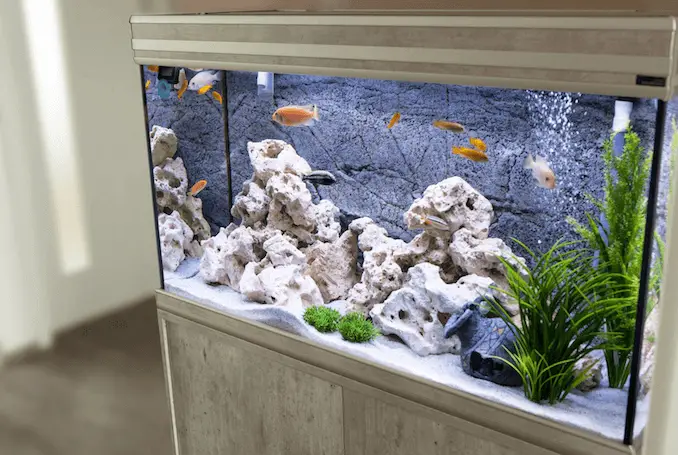
Before we begin to take a look at techniques to clean your fish tank, nosotros are going to take a expect at the regular daily and weekly maintenance tasks you should undertake to ensure your tank remains in a healthy condition in between cleans.
Daily Tank Maintenance
These daily chores will just have a few minutes and make all the difference to maintaining a healthy tank.
- Feed your fish twice a mean solar day and remove whatever uneaten nutrient after a period of five minutes (this will cease whatever uneaten food from breaking down and affecting the water quality).
- Have a quick check over all the fish in your tank (i.eastward. are they all behaving normally, no injuries, and disease gratis?).
- Check the water temperature and the specific gravity of the water (by monitoring these ii parameters daily, yous tin rapidly and easily rectify whatever adjustments).
Weekly Tank Maintenance
- Water checks – pH, nitrate, nitrite and ammonia levels, and salinity (in saltwater tanks). You lot can either have your water tested at your local fish store or just buy a home testing kit. Home kits are extremely elementary to use, they are color-coded strips of paper that help y'all to determine the levels in your tank.
- Brief bank check over your equipment – the filter, lights etc. This but needs to be a quick check to ensure everything is working properly, the rest can exist washed during the tank make clean.
How Oftentimes Should Y'all Clean Your Tank?
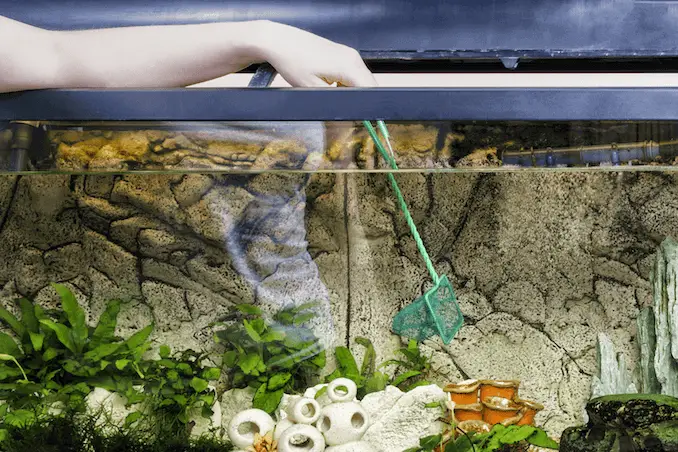
The amount of water you demand to replace, and the regularity of your water changes will entirely depend on the size of your tank, and the amount of fish yous accept in there.
As a guideline, you should aim to give your freshwater tank a partial h2o change of 10-20% every 2 – 3 weeks.
Advertisements
For a saltwater tank, you should change 10% of the h2o every week for the start year of keeping the aquarium, you tin then follow a similar guideline to freshwater tanks.
If you maintain your tank correctly, yous should never need to do a full water alter, in fact, by doing this; you lot will be removing all the bacteria which are essential in breaking down the waste your fish create.
The more fish you have, the larger the bio-load and the faster the water needs changing; the same goes for smaller tanks as the water becomes unstable.
During the first few months of keeping fish, you should monitor the water conditions of the tank regularly.
You'll start to get a skilful idea as to how often your tank should be cleaned when you lot continue a record of all the parameters.
The parameters depend entirely on the species which you lot are keeping, simply you lot can use the parameters below as a guideline.
Remember different species accept more specific requirements and so you lot should always research the fish, corals or invertebrates that y'all are keeping in your aquarium to check the acceptable parameters.
Freshwater Parameters
| Parameter | Freshwater | Brackish | Pond |
| Temperature | 72 – 82oF | 72 – 82oF | 33 – 76oF |
| pH | half-dozen.five – 7.5 | vii.five – 8.4 | 6.v – 7.5 |
| Alkalinity (Carbonate Hardness) | four – 8 KH | 10 – 18 KH | 4 – 8 KH |
| General Hardness | four – 12 GH | 12 – 20 GH | 4 – 12 GH |
| Ammonia | 0.0 | 0.0 | 0.0 |
| Nitrate | 0.0 | 0.0 | 0.0 |
| Nitrate | <fifty ppm | <fifty ppm | <l ppm |
Saltwater Parameters
| Parameter | FOWLR Aquarium | Reef Aquarium | Coral Reef |
| Temperature | 72 – 82oF | 72 – 82oF | 82oF |
| pH | eight.1 – viii.4 | 8.ane – 8.four | 8.0 – 8.5 |
| Alkalinity (Carbonate Hardness) | 8 – 12 dKH | eight – 12 dKH | 6 – 8 dKH |
| Specific Gravity | one.020 – 1.025 | 1.023 – i.025 | one.025 |
| Ammonia (NH3) | Undetectable | Undetectable | Well-nigh Zero |
| Nitrite (NO2) | Undetectable | Undetectable | Most Naught |
| Nitrate – Nitrogen (NO3) | <30 ppm | <1.0 ppm | 0.25 ppm |
| Phosphate (PO4) | <1.0 ppm | <0.2 ppm | 0.13ppm |
| Calcium | 350 – 450 ppm | 350 – 450 ppm | 380 – 420 ppm |
| Magnesium | 1150 – 1350 ppm | 1250 – 1350 ppm | 1300 ppm |
| Iodine | 0.04 – 0.10 ppm | 0.06 – 0.ten ppm | 0.06 ppm |
| Strontium | four – 10 ppm | eight – 14 ppm | 8 – 10 ppm |
How to Clean your Tank in Five Easy Steps
- Preparation
- Water Removal
- Algae Removal
- Filter Cleaning
- Water Replacement
Footstep Ane – Training
Get together all the supplies you need; listed below.
Supplies Yous Will Need to Clean
- A siphon gravel vacuum
- Algae scraper/pad (we recommend a magnetic cleaner)
- Large bucket (make certain this is only ever used for cleaning your aquarium then households chemicals don't get into your tank)
- New filter media (optional)
- Used clean towel/cloth
- Prepared water (the corporeality and blazon will depend on how much y'all need to supersede and whether you have a saltwater or freshwater tank)
- Water testing kit
- Powerhead and heater (saltwater aquarium)
- A salinity probe (saltwater aquarium)
The majority of aquariums are likewise heavy to movement, and then y'all'll need a siphon that allows yous to take water out of the tank and a bucket that allows yous to bring replacement water to the tank.
Unplug all the electrical elements in your aquarium including; heater, filter, and any pumps.
Remove any large decorations or ornaments.
Elevation-Tip
Make sure you practise this slowly and so you don't stir upwards any debris at the bottom of the tank.
If you have artificial plants, y'all can remove them if they need a clean, just never remove live plants – this will disturb the root growth.
Footstep Two – Water Removal
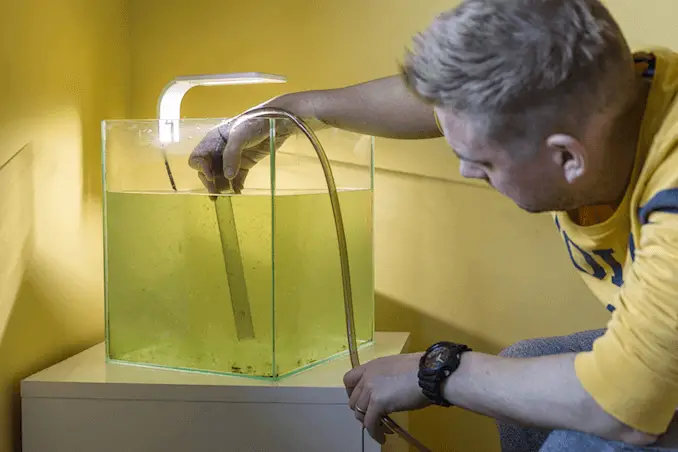
You'll need to supplant roughly ten-twenty% of the h2o in your aquarium every 2-iii weeks.
Use a siphon gravel vacuum, with an fastened hose to make clean the gravel and remove the h2o.
You should suck upwards small-scale amounts of gravel using the siphon, the waste will and so be sucked through the tube into the bucket forth with some of the water, and the gravel will fall back into place.
Use your thumb to block the end of the tube to slow down the siphoning process, and make sure none of the gravel makes it into the tube.
Some siphons have a built-in regulator to control the flow of water, some as well come up with longer hoses so the h2o can be taken straight to the sink (if you don't demand to keep it to wash other equipment in).
Non just does this footstep remove the h2o, but it also cleans the gravel past removing plenty of the waste material that has fallen into the substrate.
Step Iii – Remove Algae
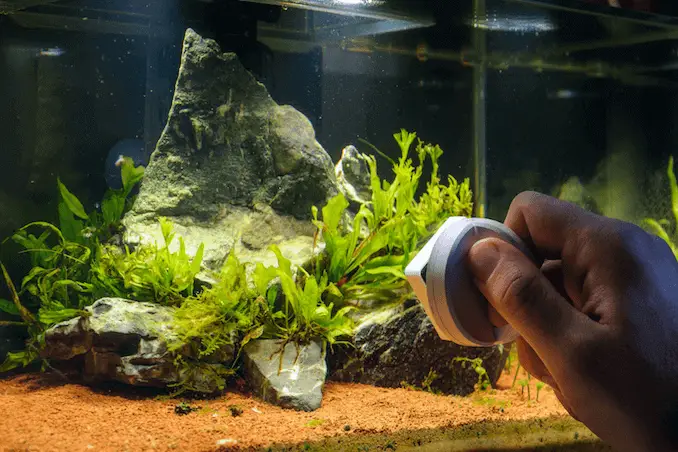
The easiest manner to clean the glass in your tank is to use a magnetic algae cleaner.
A magnetic algae cleaner consists of two magnets with a soft felt covering. Y'all place i magnet on the within of the aquarium, and attach the other to the outside of the aquarium.
Yous and then elevate the outer magnet around the drinking glass of the aquarium, and the inner magnets follow and gently remove the majority of the algae.
If yous have an acrylic aquarium, be sure to choose a cleaner that won't scratch the surface.
If y'all want to clean whatever of the other larger decorations you've removed (from stride 2), you can practise this in the saucepan of siphoned out water; using a make clean soft-bristled toothbrush.
Advertisements
Never apply soap or other cleaning products; this can be deadly to your fish.
You might besides want to consider having a clean-up crew, which will eat some of the algae in the tank.
Step Iv – Filter Cleaning
Depending on the blazon and quality of filter that you use, you volition need to clean and sometimes change the medium in your water filter.
The most common blazon of filter is a sponge filter. To clean this, you should remove information technology and rinse information technology out in the bucket of water that you have removed from the tank.
Never run your filter under tap water, because information technology removes the beneficial bacteria which is has built up which is necessary for your tank.
Advertisements
Whatever other filters which human action every bit a mechanical filter, as a sponge does (ceramic rings, filter fiber etc) should likewise be rinsed and returned as speedily equally possible to avert losing the bacteria colonies.
If your filter contains carbon, ammonia absorbers, or, ion-exchange resins it will demand replacing every couple of weeks because information technology volition no longer be able to absorb materials.
You should also clean the rest of the filter, including the tubing; use a filter brush for this.
Step V – Water Replacement
Your aquarium at present needs to be topped back up with water.
The type of h2o you add depends on whether you have a saltwater tank or a freshwater tank.
Advertisements
Freshwater Water Preparation
If you accept time to prepare the water in accelerate, leave the tap water out for 24 hours in advance of cleaning your tank to permit the chlorine in the water to evaporate.
You'll need to use a water conditioner to remove any of the heavy metals, chlorine and toxins which are harmful to fish.
By preparing your water in advance, this allows the water to achieve room temperature likewise.
Saltwater H2o Preparation
You'll need to be more than precise with h2o changes in saltwater tanks. You demand to notice three parameters – salinity, temperature and pH.
For reef aquariums you'll demand RO/DI h2o (reverse osmosis and/or deionized h2o). You can buy this from your local fish store, or you can buy a arrangement which produces RO-DI h2o. Ideally you should apply this water for any type of saltwater tank.
You should only employ tap h2o if your local supply is excellent, and even and so, tap water should but be used for fish-but aquariums. If y'all accept to use tap water, accept it tested for TDS (full Dissolved Solids) this reading should be zero, merely anything less than 10 is OK.
Y'all'll need to dechlorinate the water so add a salt mix. At that place are lots of dissimilar options available, so make sure y'all choose a quality and reputable brand. Follow the instructions according to the product you choose.
Most salt mixes will need to exist added to warm water which is moving. Yous tin do this with a powerhead and a heater.
You should go out the h2o over night before adding it to the aquarium, to allow the salt to completely dissolve.
Always make sure the temperature and salinity of the water is as like as possible before yous put in back into the aquarium; this avoids sudden changes in your tank.
Check the h2o parameters in your aquarium later a couple of hours, and also check that the h2o is not cloudy.
Finally, you tin can clean the exterior of your tank just using an aquarium canonical glass cleaned and a cloth.
Fish Tank Cleaning FAQs
How do I clean a used fish tank?
The tank should be completely empty before you clean it. You lot'll demand salt, vinegar and some soft scrubbing pads.
The vinegar and salt volition remove any difficult water stains and fishy smells. Brand sure you rinse the tank thoroughly before calculation any water to it.
Once the tank has had a thorough clean, fill it upward with water to cheque there are no leaks. If you do find leaks, you tin use aquarium sealant.
How do I clean a fish tank which has eggs in information technology?
If the eggs were laid in the gravel, you can go ahead with your usual clean but just avert the gravel areas until the eggs take hatched and the fry are swimming.
If they have been laid anywhere else – just avoid that surface area during your clean upwardly and don't betrayal them to air.
Advertisements
Almost eggs hatch within a week and so they shouldn't really touch on your cleaning schedule.
Should I e'er remove my fish?
Unless you lot have a very pocket-size tank or bowl, you lot do not need to remove your fish while you're doing water changes.
Fish do not like being disturbed and removing them can crusade stress. If you lot absolutely take to, keep them in the same water every bit their aquarium.
Ideally, you lot should exercise much more frequent partial water changes even with a small aquarium or bowl.
Summary
Cleaning your aquarium should not be a laborious task, the key to keeping your aquarium make clean is regular and ongoing maintenance.
Partial water changes are 1 of the most important aspects of ensuring your fish stay healthy and happy.
Making partial water changes ensures that the bacteria colonies, which are essential for your aquarium, are not removed or damaged.
It'south not a hard task; merely follow the steps we have provided!
Source: https://www.fishkeepingworld.com/how-to-clean-a-fish-tank/
Posted by: smithexciou.blogspot.com


0 Response to "How Do You Keep A 100 Gallon Tank Clean"
Post a Comment